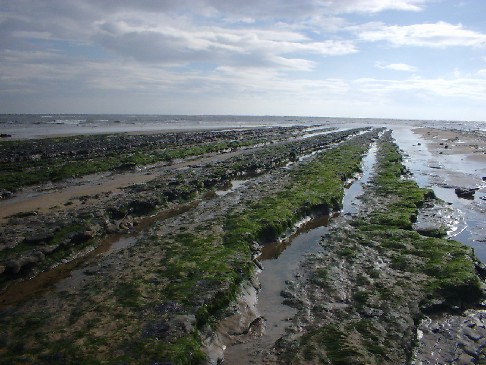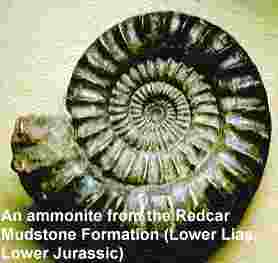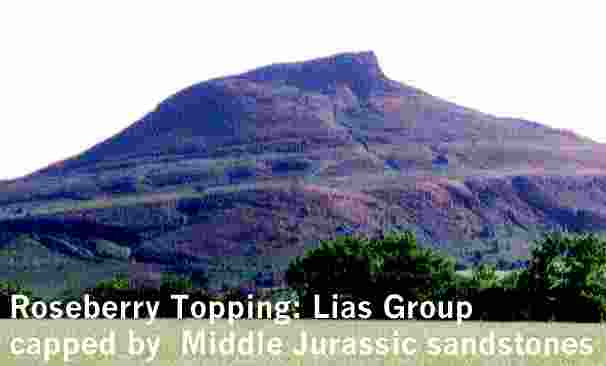|
 By
Jurassic times Britain had reached the latitude of the present day
Mediterranean. During this period the North York Moors area was a subsiding
basin. This factor, together with a eustatic (worldwide)
rise in sea-level, led to thousands of feet of sediment being deposited in
this basin during Jurassic times. During late Cretaceous- Tertiary times, due
to Earth movements, the basin was inverted. By
Jurassic times Britain had reached the latitude of the present day
Mediterranean. During this period the North York Moors area was a subsiding
basin. This factor, together with a eustatic (worldwide)
rise in sea-level, led to thousands of feet of sediment being deposited in
this basin during Jurassic times. During late Cretaceous- Tertiary times, due
to Earth movements, the basin was inverted.
The rocks are divided into Lower, Middle and Upper
Jurassic. The first marine sediments (Lower Jurassic) that were deposited are
known as the Lias Group. They are a thick sequence
of richly fossiliferous mudstones (calcareous in
part), siltstones, shallow marine sandstones and ironstones, the latter composed
predominantly of an iron carbonate, siderite. Abundant ammonites, e.g. Arietites and Dactylioceras
allow a very precise dating and correlation of the sequence. It is within
this Group that, in addition to the ironstones, the alum shales
and jet rock are found all of which were of economic importance historically.
Photo
to the left shows bedded limestones and mudstones
of Lower Jurassic Rocks at Redcar
|
|
 During Middle Jurassic times, a delta, or coastal
plain spread from the landmass to the north. This deposited a sequence of
sandstones, siltstones, shales
and minor coals. There were, however, at least two marine transgressions
during Middle Jurassic times. Middle Jurassic rocks are famous for fossil
dinosaur footprints which can be seen on the shore in fallen blocks of the Saltwick (Hayburn) Fm. between Whitby and Saltwick Bay, and
also on the shore in rocks of the Scalby Fm. at Burniston, north of Scarborough. During Middle Jurassic times, a delta, or coastal
plain spread from the landmass to the north. This deposited a sequence of
sandstones, siltstones, shales
and minor coals. There were, however, at least two marine transgressions
during Middle Jurassic times. Middle Jurassic rocks are famous for fossil
dinosaur footprints which can be seen on the shore in fallen blocks of the Saltwick (Hayburn) Fm. between Whitby and Saltwick Bay, and
also on the shore in rocks of the Scalby Fm. at Burniston, north of Scarborough.
Photo's of dinosaur footprints.
Plant beds are also famous such as
those at Hasty Bank, Whitby, Botton
Head, Roseberry Topping and the Gristhorpe Plant
Bed at the southeast end of Cayton Bay. The disused
quarry (in the Saltwick Fm.) towards the top of the
eastern end of Errington Wood east of New Marske was once famous for fossil plants, but it is now
so overgrown that it is extremely difficult to find any.
Photo's of Whitby's Lower
and Middle Jurassic geology can be viewed here.
|
|
 A
return to fully marine conditions occurred during Upper Jurassic times and
the rocks of this age consist of marine limestones,
calcareous sandstones and mudstones. The resistant calcareous sandstones and limestones in fact form a distinct north facing scarp in
the southern North York Moors as well as the reef at Filey
Brigg. The steep slope of Newgate Bank on the Stokesley-Helmsley road, for example, and the slope
leading up to the Hole of Horcum are due to this
scarp. The youngest Jurassic rocks in Yorkshire are mudstones, the Kimmeridge Clay which is the principal source rock for
North Sea oil. Unfortunately it is very poorly exposed. It can be seen at the
base of the cliffs near Speeton, S.E. of Filey when there is not too much sand. A
return to fully marine conditions occurred during Upper Jurassic times and
the rocks of this age consist of marine limestones,
calcareous sandstones and mudstones. The resistant calcareous sandstones and limestones in fact form a distinct north facing scarp in
the southern North York Moors as well as the reef at Filey
Brigg. The steep slope of Newgate Bank on the Stokesley-Helmsley road, for example, and the slope
leading up to the Hole of Horcum are due to this
scarp. The youngest Jurassic rocks in Yorkshire are mudstones, the Kimmeridge Clay which is the principal source rock for
North Sea oil. Unfortunately it is very poorly exposed. It can be seen at the
base of the cliffs near Speeton, S.E. of Filey when there is not too much sand.
A famous Lower Jurassic site can be
visited here.
|
|
 From:
Phanerozoic Polar Wander,
Palaeogeography and Dynamics From:
Phanerozoic Polar Wander,
Palaeogeography and Dynamics
Trond H. Torsvik , Rob Van der Voo, Ulla
Preeden , Conall Mac Niocaill , Bernhard Steinberger, Pavel
V. Doubrovine, Douwe J.J.
van Hinsbergen, Mathew Domeier
,Carmen Gaina, Eric Tohveri, Joseph G. Meert,
Phil J. A. McCausland, L. Robin M. Cocks
Notice
how Britain is roughly same latitude as present day Mediterranean and that
Atlantic Ocean is opening.
|



